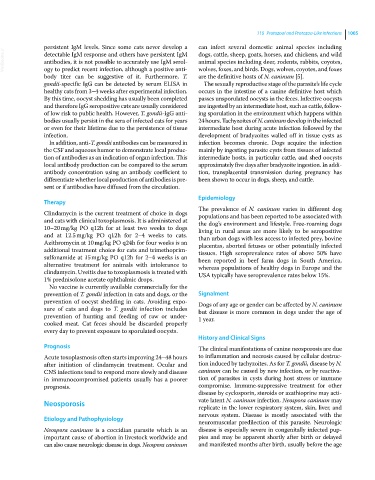Page 1067 - Clinical Small Animal Internal Medicine
P. 1067
110 Protozoal and Protozoa‐Like Infections 1005
persistent IgM levels. Since some cats never develop a can infect several domestic animal species including
VetBooks.ir detectable IgM response and others have persistent IgM dogs, cattle, sheep, goats, horses, and chickens, and wild
animal species including deer, rodents, rabbits, coyotes,
antibodies, it is not possible to accurately use IgM serol-
ogy to predict recent infection, although a positive anti-
are the definitive hosts of N. caninum [5].
body titer can be suggestive of it. Furthermore, T. wolves, foxes, and birds. Dogs, wolves, coyotes, and foxes
gondii‐specific IgG can be detected by serum ELISA in The sexually reproductive stage of the parasite’s life cycle
healthy cats from 3–4 weeks after experimental infection. occurs in the intestine of a canine definitive host which
By this time, oocyst shedding has usually been completed passes unsporulated oocysts in the feces. Infective oocysts
and therefore IgG seropositive cats are usually considered are ingested by an intermediate host, such as cattle, follow-
of low risk to public health. However, T. gondii‐IgG anti- ing sporulation in the environment which happens within
bodies usually persist in the sera of infected cats for years 24 hours. Tachyzoites of N. caninum develop in the infected
or even for their lifetime due to the persistence of tissue intermediate host during acute infection followed by the
infection. development of bradyzoites walled off in tissue cysts as
In addition, anti‐T. gondii antibodies can be measured in infection becomes chronic. Dogs acquire the infection
the CSF and aqueous humor to demonstrate local produc- mainly by ingesting parasite cysts from tissues of infected
tion of antibodies as an indication of organ infection. This intermediate hosts, in particular cattle, and shed oocysts
local antibody production can be compared to the serum approximately five days after bradyzoite ingestion. In addi-
antibody concentration using an antibody coefficient to tion, transplacental transmission during pregnancy has
differentiate whether local production of antibodies is pre- been shown to occur in dogs, sheep, and cattle.
sent or if antibodies have diffused from the circulation.
Epidemiology
Therapy
The prevalence of N. caninum varies in different dog
Clindamycin is the current treatment of choice in dogs populations and has been reported to be associated with
and cats with clinical toxoplasmosis. It is administered at the dog’s environment and lifestyle. Free‐roaming dogs
10–20 mg/kg PO q12h for at least two weeks to dogs living in rural areas are more likely to be seropositive
and at 12.5 mg/kg PO q12h for 2–4 weeks to cats. than urban dogs with less access to infected prey, bovine
Azithromycin at 10 mg/kg PO q24h for four weeks is an placentas, aborted fetuses or other potentially infected
additional treatment choice for cats and trimethoprim‐ tissues. High seroprevalence rates of above 50% have
sulfonamide at 15 mg/kg PO q12h for 2–4 weeks is an been reported in beef farm dogs in South America,
alternative treatment for animals with intolerance to whereas populations of healthy dogs in Europe and the
clindamycin. Uveitis due to toxoplasmosis is treated with USA typically have seroprevalence rates below 15%.
1% prednisolone acetate ophthalmic drops.
No vaccine is currently available commercially for the
prevention of T. gondii infection in cats and dogs, or the Signalment
prevention of oocyst shedding in cats. Avoiding expo- Dogs of any age or gender can be affected by N. caninum
sure of cats and dogs to T. gondii infection includes but disease is more common in dogs under the age of
prevention of hunting and feeding of raw or under- 1 year.
cooked meat. Cat feces should be discarded properly
every day to prevent exposure to sporulated oocysts.
History and Clinical Signs
Prognosis The clinical manifestations of canine neosporosis are due
Acute toxoplasmosis often starts improving 24–48 hours to inflammation and necrosis caused by cellular destruc-
after initiation of clindamycin treatment. Ocular and tion induced by tachyzoites. As for T. gondii, disease by N.
CNS infections tend to respond more slowly and disease caninum can be caused by new infection, or by reactiva-
in immunocompromised patients usually has a poorer tion of parasites in cysts during host stress or immune
prognosis. compromise. Immune‐suppressive treatment for other
disease by cyclosporin, steroids or azathioprine may acti-
Neosporosis vate latent N. caninum infection. Neospora caninum may
replicate in the lower respiratory system, skin, liver, and
nervous system. Disease is mostly associated with the
Etiology and Pathophysiology
neuromuscular predilection of this parasite. Neurologic
Neospora caninum is a coccidian parasite which is an disease is especially severe in congenitally infected pup-
important cause of abortion in livestock worldwide and pies and may be apparent shortly after birth or delayed
can also cause neurologic disease in dogs. Neospora caninum and manifested months after birth, usually before the age

